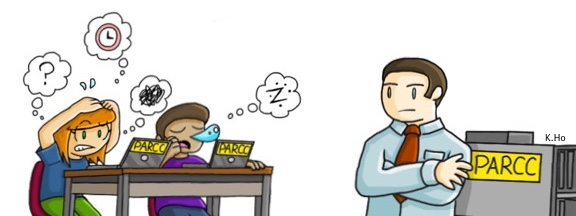New standardized test no walk in the park

March 20, 2015
At this time of year, with AP exams fast approaching, students are left scrambling to finish curricula, master skills and salvage their third quarter grades. However, some students, mainly from the sophomore class, were required to put their current classes on the back burner while they fulfilled the senseless mandate of the state: PARCC assessments.
PARCC assessments are a new test that will be replacing the HSA, Maryland’s current graduation requirement exam. The PARCC assessments differ in that they are administered on a computer and are much more complex in terms of how a student must solve the problems.
As the tests are a new concept, there was much confusion surrounding graduation requirements, test-taking techniques and the logistics of test administration. The mess that was PARCC testing calls into question the wisdom of sacrificing valuable classroom and learning time for poorly planned testing.
Those students who had to take the tests were not allotted a time during the school day in a specialized schedule for the event. Instead, students had to miss their core subject classes in order to take the tests, a hindrance for students in a school year that has been riddled with snow days and delays.
According to assistant Principal Joshua Neuman-Sunshine, the time required for the test varies depending on the subject. The total amount of time to administer the Algebra 1 and 2 tests is about three hours and 20 minutes. The English 10 test is spread over two days, with a combined total of five hours.
After missing as much school as we have due to weather, the last thing a student needs is more absences from class. Maryland public school officials need to determine if their short-term tests are really more important that the long-term learning of students.
Under the administration of the HSA, the entire school worked around a specialized schedule that ensured that test-taking students would not be behind their classmates once the test was finished. By requiring certain students to miss class, but allowing others to attend, the state is essentially “picking favorites.”
According to PARCC Assessment Overview, there will be two parts of the tests, one in March and one in April.
Thus, students must go through this ordeal not once, but twice. For current sophomores, they will taking Biology and Government HSAs, so the amount of state testing one student is subjected to for the year is far greater than it needs to be.
The PARCC Assessments are not only detrimental to the students who have to take them, but also to students and teachers who must work around them. Teachers who needed labs during the time of test administering had to forgo the instruction they planned and postpone certain lesson plans, thus affecting any student in one of these classes. Teachers who had large percentages of their classes absent due to the testing also had to work around the tests in order to ensure that their classes were all on the same page.
Had the tests been better planned, with time designated for testing in which no classes were missed, the entire event could have been as seamless as HAS week has been in the past.
Besides the obvious issues with scheduling, the tests’ technology had its fair share of flaws.
According to several students who took the tests, there were issues with logging on and the technical aspects of the test. In one class, students could not log on and were required to miss an additional day of class to make-up the test.
Neuman-Sunshine acknowledged that there were indeed “minor technical difficulties,” but he believes that the tests in general went relatively well.
Taking the tests online, especially the math portions, was also difficult for students to take. Though students were provided with scratch paper, they were required to show work on the computer, an arduous feat for students accustomed to doing their work on paper.
According to MCPS Public Information Officer Dana Tofig, electronic testing is the testing of the future.
However, in order to ensure that students perform well on these tests, they should have been adequately prepared for this new way of administering tests.
The idea of a new form of testing that better prepares students for college and careers is not a bad one, if instituted properly, as education systems must constantly undergo reform and advancement. The problem with the PARCC tests was that this transition was applied in a way that made the tests a burden for all students and teachers involved. This experience can serve as an example for the future. Tests should be planned out to be as unobtrusive and easy as possible.

